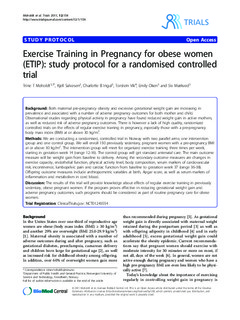| dc.contributor.author | Moholdt, Trine Tegdan | |
| dc.contributor.author | Salvesen, Kjell Å | |
| dc.contributor.author | Ingul, Charlotte Bjørk | |
| dc.contributor.author | Vik, Torstein | |
| dc.contributor.author | Oken, Emily | |
| dc.contributor.author | Mørkved, Siv | |
| dc.date.accessioned | 2019-10-08T10:41:25Z | |
| dc.date.available | 2019-10-08T10:41:25Z | |
| dc.date.created | 2012-01-09T18:18:08Z | |
| dc.date.issued | 2011 | |
| dc.identifier.citation | Trials. 2011, 12 (154), 1-6. | nb_NO |
| dc.identifier.issn | 1745-6215 | |
| dc.identifier.uri | http://hdl.handle.net/11250/2620851 | |
| dc.description.abstract | Both maternal pre-pregnancy obesity and excessive gestational weight gain are increasing in prevalence and associated with a number of adverse pregnancy outcomes for both mother and child. Observational studies regarding physical activity in pregnancy have found reduced weight gain in active mothers, as well as reduced risk of adverse pregnancy outcomes. There is however a lack of high quality, randomized controlled trials on the effects of regular exercise training in pregnancy, especially those with a pre-pregnancy body mass index (BMI) at or above 30 kg/m2.
Methods
We are conducting a randomised, controlled trial in Norway with two parallel arms; one intervention group and one control group. We will enroll 150 previously sedentary, pregnant women with a pre-pregnancy BMI at or above 30 kg/m2. The intervention group will meet for organized exercise training three times per week, starting in gestation week 14 (range 12-16). The control group will get standard antenatal care. The main outcome measure will be weight gain from baseline to delivery. Among the secondary outcome measures are changes in exercise capacity, endothelial function, physical activity level, body composition, serum markers of cardiovascular risk, incontinence, lumbopelvic pain and cardiac function from baseline to gestation week 37 (range 36-38). Offspring outcome measures include anthropometric variables at birth, Apgar score, as well as serum markers of inflammation and metabolism in cord blood.
Discussion
The results of this trial will provide knowledge about effects of regular exercise training in previously sedentary, obese pregnant women. If the program proves effective in reducing gestational weight gain and adverse pregnancy outcomes, such programs should be considered as part of routine pregnancy care for obese women. | nb_NO |
| dc.language.iso | eng | nb_NO |
| dc.publisher | BMC (part of Springer Nature) | nb_NO |
| dc.rights | Navngivelse 4.0 Internasjonal | * |
| dc.rights.uri | http://creativecommons.org/licenses/by/4.0/deed.no | * |
| dc.title | Exercise Training in Pregnancy for obese women (ETIP): study protocol for a randomised controlled trial | nb_NO |
| dc.type | Journal article | nb_NO |
| dc.type | Peer reviewed | nb_NO |
| dc.description.version | publishedVersion | nb_NO |
| dc.source.pagenumber | 1-6 | nb_NO |
| dc.source.volume | 12 | nb_NO |
| dc.source.journal | Trials | nb_NO |
| dc.source.issue | 154 | nb_NO |
| dc.identifier.doi | 10.1186/1745-6215-12-154 | |
| dc.identifier.cristin | 880360 | |
| dc.description.localcode | © 2011 Moholdt et al; licensee BioMed Central Ltd. This is an Open Access article distributed under the terms of the Creative Commons Attribution License (http://creativecommons.org/licenses/by/2.0), which permits unrestricted use, distribution, and reproduction in any medium, provided the original work is properly cited. | nb_NO |
| cristin.unitcode | 194,65,25,0 | |
| cristin.unitcode | 194,65,20,0 | |
| cristin.unitcode | 1920,13,0,0 | |
| cristin.unitcode | 194,65,15,0 | |
| cristin.unitname | Institutt for sirkulasjon og bildediagnostikk | |
| cristin.unitname | Institutt for samfunnsmedisin og sykepleie | |
| cristin.unitname | Kvinneklinikken | |
| cristin.unitname | Institutt for klinisk og molekylær medisin | |
| cristin.ispublished | true | |
| cristin.fulltext | original | |
| cristin.qualitycode | 1 | |

